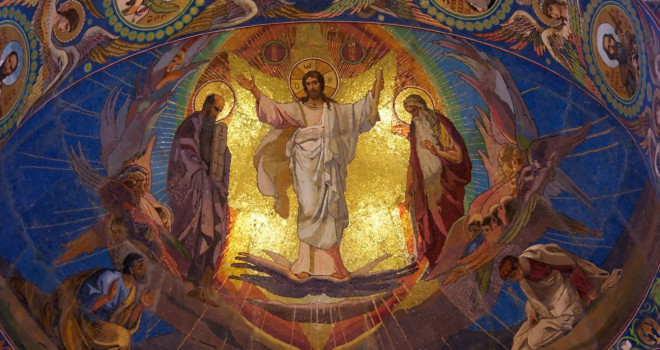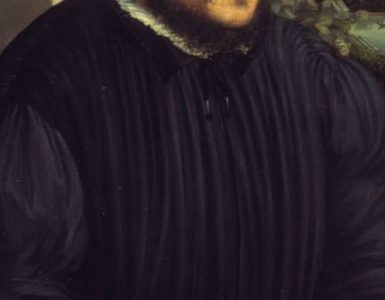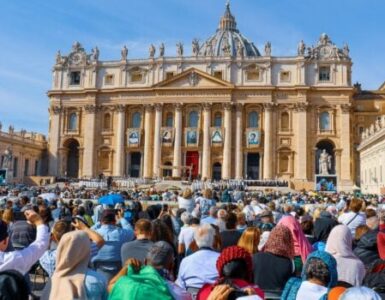Let’s be honest, most of us don’t pray nearly as much as we could. It’s not that we don’t believe in prayer; it’s that prayer can seem so…boring. If you’re like me, you’ve probably gone through seasons where you’ve spent more time reading about prayer than actually praying. It’s embarrassing: the eternal God condescends to be known by us, to know us, and we…yawn.
When we’re honest, I think one reason why so many of us find prayer so easy to avoid is because we forget that to pray is to create. If your prayer life is in a lull, I want to invite you to rediscover the power of imagination, and by “imagination” I do not mean drifting off into la-la land. I mean a creative effort. It’s time to get on your knees, pull out the Crayolas of your soul, and to start scribbling.
At first, a blank page can be overwhelming. Jesus knew it would be. And that’s why he gave us the first ever Prayer Coloring Book: the Pater Noster, the Lord’s Prayer. By learning how to color inside these lines, we’ll learn how to make the dullest, grayest moments an outburst of creative energy, holy praising, desperate grieving, audacious asking, resting. Friends, it’s time to learn how to pray in colors rich and enduring. “Because when you are imaging,” says Anne of Green Gables, “you might as well imagine something worthwhile.”
Scope for the Imagination
To pray is to create—to bring a conversation with God into being where there would have otherwise been nothing, at least on your end—and pre-written prayers like the Pater Noster are a good place start. You don’t have to be the spiritual equivalent of a Giotto or Michelangelo. Anyone can pray in reds and blues and greens and oranges. God owns the copyright on color, and he gives it away for free.
When we pray, an enormous creative effort is happening, just beneath the surface of our awareness. Our Father, who art in Heaven. Unbidden, an assumption, almost like a curtain, hangs in the background, this family, this great army, this “we” with whom we are saying “our Father.” Lightning-fast, an image flashes before us: a bearded man, perhaps, or a hot metaphysical glow, or a Zeus-like warrior wrapped in thunder. The Father. He’s not just anywhere. He’s in Heaven, a city shooting out of the clouds like a thousand golden trumpets standing upright in the sunlight, just waiting to be played. It’s Gondor, planet Pandora, Ireland, New York to the umpteenth degree except baptized. Our Father, who art in Heaven.
The next line races down the tracks straight at us. Hallowed, hallowed, hallowed. It shoots into the tunnels of our minds in a puff of smoke. Cabin by cabin, we assimilate it. Hallowed. Be. Thy. Name. And then, nothing. Enveloped in the luminous darkness, time stands still. There’s not a sound. And then, with a crash, just beneath the surface of our consciousness, the line bursts out of the tunnel and we see a thousand paintings, ten thousand cathedrals, and we’ve only just begun to pray the Pater Noster.
Unless, of course, we are not using our imaginations. Prayer is about as exhilarating as reciting the Pledge of Allegiance if you’re praying in black-and-white, and not in color. If you have no imagination, why are you surprised that your prayers are as exciting as filling out paperwork at the DMV? It’s not enough to pray the Rosary or the Pater Noster if you’re simply repeating what you’ve been told like a clenched fist inside a sock puppet. You can hardly pay attention to what you’re saying.
Be like a little child, a child at play. And if you’ve ever seen a child playing—like, really playing—you know it is deadly serious. Genuine play is no stroll around the Monopoly board. It’s real, more real than most of us can handle.
A pre-written prayer like the Pater Noster, then, does not suck the spontaneity or genuineness out of our prayer experience. The written prayer guides the way we imagine, but it does not determine it. A play begins with a playwright writing a script, but it is the director who brings that script to life. Your imagination is the director of this script, your heart is the stage, and your imagination is the play. But this is not a performance: this is a prayer. And you are praying for an audience of one—God.
In the end, only boring people think prayer is boring. They’ve turned off the lights in their hearts, leaving “no scope for the imagination.” In the end, if imagination is just impossible for you, there’s always the warm encouragement from Anne of Green Gables, “It’s been my experience that you can nearly always enjoy things if you make up your mind firmly that you will.”
The Secret Ingredient
The secret ingredient to prayer is the Holy Spirit. You can follow all the days of the liturgical year, memorize all the collects, pray the Rosary every day, and if the Holy Spirit is not praying in and through you, it’s nothing. There is only one prayer, the prayer of the Son to the Father. And everyone who has been baptized into the Son has been given the gift of the Holy Spirit, the Spirit who lifts us up into the eternal prayer of the Son to his Father.
God is the beginning and end of prayer. He is the wind in our sails. He is the safe passage and he is the harbor. He is the Creator from whom all good creativity flows. And the Creator did not give you creativity so you could squander it on the false gods of money, comfort, or the latest fashion. He gave you creativity so you could enjoy him and glorify him forever. Creativity was made for prayer, and to pray is to create.
Whether you are before the Blessed Sacrament, at your bedside, gathered around your family table, or just finishing up reading yet another blog about prayer, it’s always a good time to pull out the pastels of your heart, the watercolors of your soul, and to pray to the God of the universe. Our Father, who art in Heaven…










